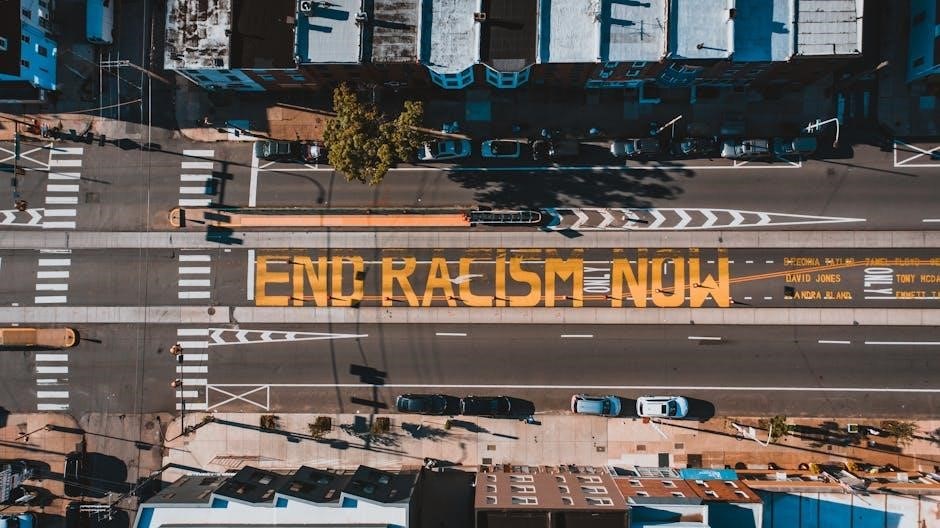Written in 1963 during the Birmingham Campaign‚ the letter addresses criticisms from local clergymen‚ defending nonviolent protest and advocating for racial justice‚ becoming a cornerstone of civil rights literature.
1.1 Historical Context of the Letter
The Letter from Birmingham Jail was written in April 1963 during the Birmingham Campaign‚ a civil rights initiative targeting segregation in one of the South’s most racially divided cities. King‚ arrested for protesting without a permit‚ penned the letter in response to local clergymen who criticized the demonstrations as untimely and disruptive. This context underscores the letter’s urgency and its role in galvanizing the civil rights movement.
1.2 Importance of the Letter in the Civil Rights Movement
The Letter from Birmingham Jail played a pivotal role in the civil rights movement by articulating the moral imperative for racial equality and nonviolent protest. It galvanized public support‚ influenced landmark legislation like the Civil Rights Act of 1964‚ and remains a powerful call to action against injustice‚ solidifying its legacy as a foundational text in the struggle for human rights.

Key Themes in the Letter
The letter explores justice‚ faith‚ and civil disobedience‚ emphasizing the moral urgency of combating racial inequality through nonviolent resistance‚ rooted in Christian ethics and universal human rights.
2.1 Justice and Injustice
Martin Luther King Jr. argues that justice is universal‚ while injustice anywhere threatens justice everywhere. He distinguishes between just laws‚ which align with moral law‚ and unjust laws‚ like segregation‚ rooted in racial oppression. King emphasizes the moral necessity to challenge unjust systems‚ advocating for civil disobedience as a means to confront and dismantle systemic inequality‚ ultimately seeking a society where true justice prevails for all.
2.2 Nonviolent Resistance
Martin Luther King Jr. emphasizes nonviolent resistance as a moral and effective strategy to challenge oppression. He highlights its purpose: to create tension that forces negotiation and exposes injustice. King argues that nonviolence is not passive but an active‚ courageous stance‚ essential for achieving social change and uniting communities in the pursuit of equality and human rights‚ aligning with his broader vision of a just society.
2.3 Faith and Religion
Martin Luther King Jr. deeply integrates faith and religion into his argument‚ drawing on biblical teachings to justify civil rights activism. As a minister‚ he frames the struggle for justice as a moral and spiritual imperative‚ emphasizing the alignment of nonviolent resistance with Christian principles. King critiques religious institutions for their complicity in injustice‚ urging them to fulfill their prophetic role in advancing equality and human dignity.

Rhetorical Structure and Style
The letter balances a respectful yet assertive tone‚ blending logical arguments with emotional appeals. King employs rhetorical devices like metaphors and biblical allusions to strengthen his persuasive power.
3.1 Tone and Audience
Martin Luther King Jr. maintains a respectful yet assertive tone‚ addressing both the clergymen who criticized him and a broader audience. His language balances firmness with empathy‚ ensuring his message resonates with diverse readers. By appealing to moral values and logic‚ King unites supporters across racial and religious lines‚ emphasizing the urgency of justice and equality.
3.2 Use of Rhetorical Devices
Martin Luther King Jr. employs powerful rhetorical devices‚ including allusions‚ metaphors‚ repetition‚ and anaphora. He references biblical figures like Paul and Amos to strengthen moral authority. Metaphors‚ such as comparing time to an “eternal enemy‚” underscore urgency. Repetition of phrases like “we must” emphasizes resolve. These devices create a persuasive and emotionally compelling argument‚ bridging logical reasoning with moral appeal to unite his audience against injustice.

Major Arguments Presented by Martin Luther King Jr.
King defends nonviolent direct action‚ arguing it creates a crisis to force negotiation‚ and critiques white moderates for prioritizing order over racial justice and equality.
4.1 Defense of Nonviolent Direct Action
Martin Luther King Jr. defends nonviolent direct action as a necessary strategy to address racial injustice. He argues that it creates a crisis‚ forcing negotiation and exposing moral dilemmas. King emphasizes that nonviolence is not the cause of violence but a response to systemic injustice‚ chosen to achieve meaningful change through peaceful confrontation rather than waiting for gradual reform.
4.2 Critique of White Moderates
King criticizes white moderates for prioritizing order over justice‚ urging them to recognize the moral urgency of civil rights. He argues their neutrality and patience hinder progress‚ as true allies must actively confront racial inequality. King emphasizes that silence in the face of injustice perpetuates oppression‚ calling for immediate action to dismantle segregation and achieve equality.

Key Quotes and Their Significance
“Injustice Anywhere is a Threat to Justice Everywhere” highlights the interconnectedness of justice‚ while “We Must Come to See that the End We Seek is a Society at Peace with Itself” emphasizes King’s vision of racial harmony‚ inspiring action and unity in the civil rights movement.
5.1 “Injustice Anywhere is a Threat to Justice Everywhere”
This iconic quote emphasizes the universality of justice‚ asserting that injustice in one place endangers justice everywhere. King uses it to justify civil rights activism in Birmingham‚ arguing that racial inequality there threatens moral stability nationwide. The statement unites people across regions‚ underscoring collective responsibility and the urgent need to address systemic racism and discrimination.
5.2 “We Must Come to See that the End We Seek is a Society at Peace with Itself”
This powerful statement highlights King’s vision of a harmonious society‚ where justice and equality prevail. He emphasizes that the ultimate goal of the civil rights movement is not merely legal reform but a deeply rooted moral transformation. The quote underscores the importance of unity‚ reconciliation‚ and the creation of a society where all individuals can live without fear of oppression or division.
The Role of Religion in the Letter
Religion plays a central role in King’s letter‚ as he draws on biblical teachings to justify civil rights activism and critique religious leaders who oppose his methods.
6.1 Biblical References and Their Impact
Martin Luther King Jr. extensively uses biblical references to legitimize his arguments‚ invoking Christian teachings to emphasize moral justice. By citing figures like the Apostle Paul and the prophet Amos‚ King aligns his cause with divine authority‚ creating a powerful moral imperative. These references not only strengthen his stance but also resonate deeply with his religious audience‚ reinforcing the righteousness of the civil rights movement.
6.2 Criticism of Religious Institutions
Martin Luther King Jr. criticizes religious institutions for their complicity in racial injustice‚ expressing disappointment with their silence and failure to actively support civil rights. He challenges the church to move beyond hollow rituals and embrace its moral responsibility to fight inequality. King urges religious leaders to align their actions with the teachings of justice and compassion‚ highlighting their crucial role in the struggle for equality.
Civil Disobedience and the Law
Dr. Martin Luther King Jr. emphasizes the necessity of civil disobedience to challenge unjust laws‚ advocating nonviolent resistance to segregation and advocating for moral justice.
7.1 The Distinction Between Just and Unjust Laws
Dr. King distinguishes just laws‚ which align with moral principles‚ from unjust ones‚ like segregation laws‚ that degrade human dignity. He argues that unjust laws are out of harmony with the greater moral law‚ justifying civil disobedience. This clear distinction underscores his belief in the moral imperative to challenge unjust systems.
7.2 The Necessity of Civil Disobedience
Dr. King emphasizes that civil disobedience is not just a right but a moral duty when faced with unjust laws. He argues that nonviolent direct action is necessary to create a crisis‚ forcing society to confront and negotiate issues like segregation. This deliberate act of defiance‚ rooted in conscience‚ challenges unjust systems and compels meaningful change‚ making it a vital tool for achieving justice.
The Impact of the Letter
Dr. King’s letter‚ written in 1963‚ significantly raised awareness about racial injustice‚ garnered nationwide support‚ and influenced the trajectory of the civil rights movement in America.
8.1 Immediate Response and Criticism
The letter sparked intense debate‚ with some praising its eloquence and moral clarity‚ while others‚ including local clergymen‚ criticized King’s methods as disruptive. Despite initial backlash‚ the letter gained widespread attention‚ shifting public opinion and galvanizing support for the civil rights cause. Its powerful arguments challenged the status quo‚ making it a pivotal moment in the fight for equality.
8.2 Long-term Influence on the Civil Rights Movement
The Letter from Birmingham Jail became a defining document of the civil rights movement‚ inspiring widespread support and shaping public discourse on racial inequality. Its powerful arguments for justice and nonviolent resistance influenced landmark legislation‚ such as the Civil Rights Act of 1964 and the Voting Rights Act of 1965. The letter remains a cornerstone of American civil rights history‚ continuing to inspire social justice movements globally.

Analysis of the Letter’s Structure
The letter is structured to build a persuasive case‚ starting with King’s justification of his presence in Birmingham‚ followed by logical arguments on justice and nonviolence.
9.1 Logical Appeal and Emotional Appeal
King masterfully blends logical reasoning with emotional depth‚ using historical examples and moral principles to justify civil disobedience; He appeals to both the intellect and conscience‚ evoking empathy through personal experiences while logically dismantling arguments against his cause. This dual approach strengthens his persuasive power‚ making the letter both intellectually compelling and emotionally resonate.
9.2 The Use of Ethos‚ Pathos‚ and Logos
King employs ethos by establishing his credibility as a moral leader and advocate for justice. Pathos is evoked through vivid descriptions of racial injustice and its emotional toll. Logos is demonstrated through logical arguments against segregation and references to historical and biblical principles‚ creating a persuasive trifecta that strengthens his appeal for equality and moral accountability.

Comparison with Other Civil Rights Documents
The letter shares themes of equality and justice with works like the “I Have a Dream” speech but uniquely addresses criticism and explains direct action‚ distinguishing it from other civil rights texts with its personal‚ jailed perspective.
10.1 Similarities with the “I Have a Dream” Speech
Both the Letter from Birmingham Jail and the “I Have a Dream” speech emphasize themes of justice‚ equality‚ and hope. They share a powerful call for racial equality‚ using persuasive rhetoric and emotional appeals. King’s use of biblical allusions and metaphors in both texts reinforces their moral urgency. Both works are cornerstone documents of the civil rights movement‚ inspiring action and unity through their message of nonviolent resistance and the vision of a harmonious society.
10.2 Differences from Other Writings by MLK
The Letter from Birmingham Jail stands out for its introspective and emotionally charged tone‚ reflecting King’s confinement and frustration. Unlike his “I Have a Dream” speech‚ which is hopeful and visionary‚ the letter is more confrontational‚ addressing criticism directly. Its structured argumentation and sharp critique of white moderates and religious institutions differentiate it from MLK’s other writings‚ which often focused on unity and reconciliation. The letter’s urgency and immediacy‚ written in response to adversity‚ set it apart from his broader‚ more aspirational speeches.
The Legacy of the Letter
The Letter from Birmingham Jail is celebrated as a landmark in American literature‚ continuing to inspire movements for justice and equality today.
11.1 Its Place in American Literature
The Letter from Birmingham Jail is widely regarded as a masterpiece of American literature‚ celebrated for its powerful rhetoric and profound exploration of justice and morality. Its accessibility and emotional depth have made it a cornerstone of civil rights literature‚ ensuring its enduring relevance and influence in shaping American thought and discourse.
11.2 Continued Relevance in Modern Times
The Letter from Birmingham Jail remains a powerful call to action against injustice‚ resonating in modern struggles for equality and human rights. Its themes of justice‚ nonviolence‚ and moral responsibility continue to inspire movements like Black Lives Matter‚ emphasizing the ongoing fight against systemic racism and inequality. The letter’s timeless message promotes dialogue and reflection‚ ensuring its relevance in addressing contemporary social issues and advocating for a just society.
The Letter from Birmingham Jail stands as a landmark document in American history‚ offering profound insights into justice‚ nonviolence‚ and faith‚ continuing to inspire global movements for equality and human rights.
12.1 Summary of Key Points
The Letter from Birmingham Jail is a pivotal document addressing racial injustice‚ advocating nonviolent resistance‚ and emphasizing moral responsibility. Martin Luther King Jr. critiques segregation‚ challenges white moderates‚ and defends civil disobedience as a means to confront unjust laws. The letter combines powerful rhetoric‚ biblical references‚ and a call to action‚ leaving a lasting impact on civil rights and social justice movements worldwide.
12.2 Final Thoughts on the Letter’s Significance
Martin Luther King Jr.’s Letter from Birmingham Jail stands as a landmark in civil rights literature‚ blending moral urgency with rhetorical brilliance. Its themes of justice‚ nonviolence‚ and faith continue to resonate‚ inspiring global movements for equality. The letter’s masterful appeal to conscience and logic solidifies its place as a timeless call to action‚ reminding us of the power of words to challenge injustice and foster transformative change.


